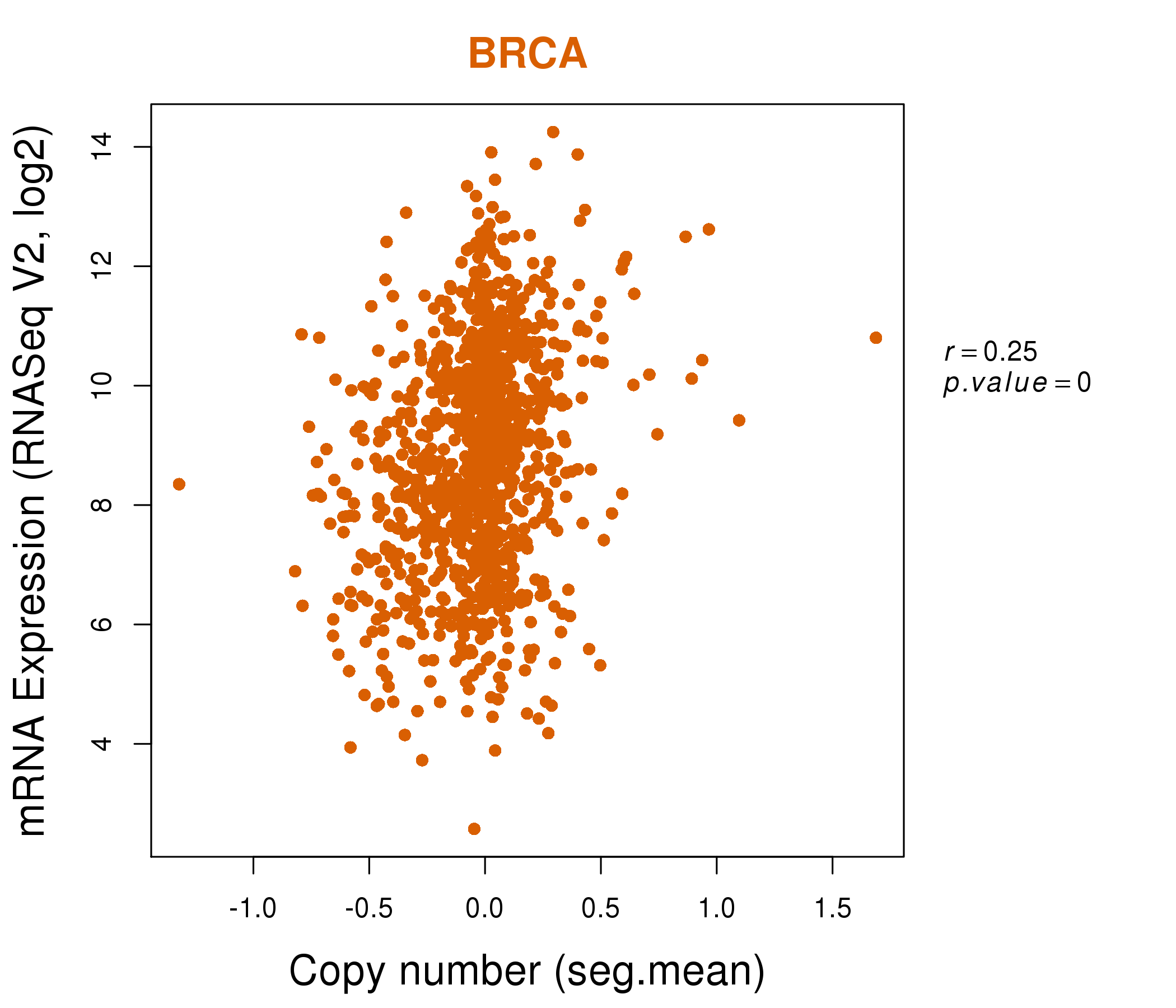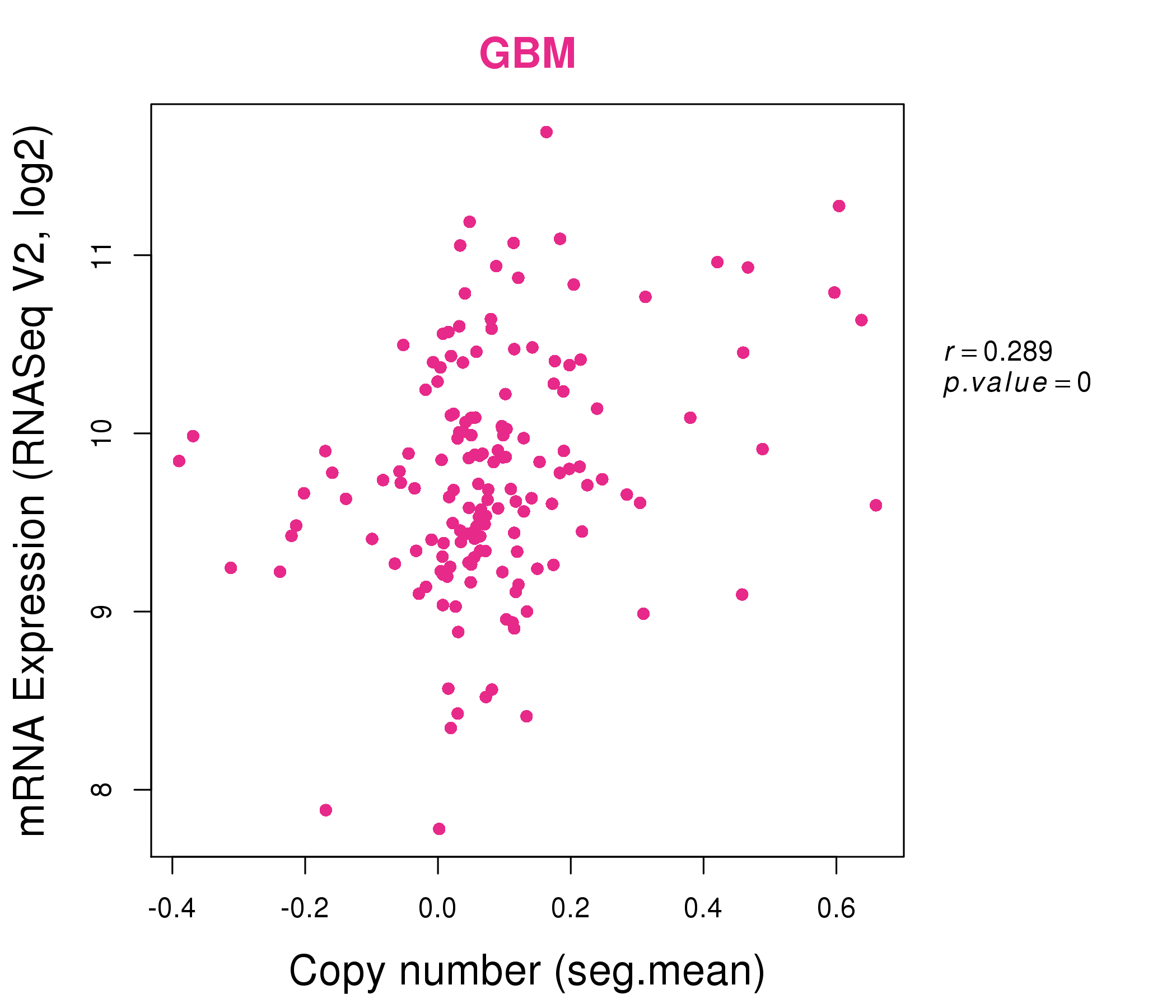|
|||||||||||||||||||||||||||||||||||||||||||||||||||||||||||||||||||||||||||||||||||||||||||||||||||||||||||||||||||||||||||||||||||||||||||||||||||||||||||||||||||||||||||||||||||||||||||||||||||||||||||||||||||||||||||||||||||||||||||||||||||||||||||||||||||||||||||||||||||||||||||||||||||||||||||||||||||||||||||||||||||||||||||||||||||||||||||||||||||||||||||||||||||||||
| |
| Phenotypic Information (metabolism pathway, cancer, disease, phenome) |
| |
| |
| Gene-Gene Network Information: Co-Expression Network, Interacting Genes & KEGG |
| |
|
| Gene Summary for GSTM2 |
| Basic gene info. | Gene symbol | GSTM2 |
| Gene name | glutathione S-transferase mu 2 (muscle) | |
| Synonyms | GST4|GSTM|GSTM2-2|GTHMUS | |
| Cytomap | UCSC genome browser: 1p13.3 | |
| Genomic location | chr1 :110210643-110226619 | |
| Type of gene | protein-coding | |
| RefGenes | NM_000848.3, NM_001142368.1, | |
| Ensembl id | ENSG00000213366 | |
| Description | GST class-mu 2GST, muscleS-(hydroxyalkyl)glutathione lyase M2glutathione S-alkyltransferase M2glutathione S-aralkyltransferase M2glutathione S-aryltransferase M2glutathione S-transferase 4glutathione S-transferase M1glutathione S-transferase M2 (m | |
| Modification date | 20141207 | |
| dbXrefs | MIM : 138380 | |
| HGNC : HGNC | ||
| Ensembl : ENSG00000213366 | ||
| HPRD : 00710 | ||
| Vega : OTTHUMG00000011638 | ||
| Protein | UniProt: go to UniProt's Cross Reference DB Table | |
| Expression | CleanEX: HS_GSTM2 | |
| BioGPS: 2946 | ||
| Gene Expression Atlas: ENSG00000213366 | ||
| The Human Protein Atlas: ENSG00000213366 | ||
| Pathway | NCI Pathway Interaction Database: GSTM2 | |
| KEGG: GSTM2 | ||
| REACTOME: GSTM2 | ||
| ConsensusPathDB | ||
| Pathway Commons: GSTM2 | ||
| Metabolism | MetaCyc: GSTM2 | |
| HUMANCyc: GSTM2 | ||
| Regulation | Ensembl's Regulation: ENSG00000213366 | |
| miRBase: chr1 :110,210,643-110,226,619 | ||
| TargetScan: NM_000848 | ||
| cisRED: ENSG00000213366 | ||
| Context | iHOP: GSTM2 | |
| cancer metabolism search in PubMed: GSTM2 | ||
| UCL Cancer Institute: GSTM2 | ||
| Assigned class in ccmGDB | C | |
| Top |
| Phenotypic Information for GSTM2(metabolism pathway, cancer, disease, phenome) |
| Cancer | CGAP: GSTM2 |
| Familial Cancer Database: GSTM2 | |
| * This gene is included in those cancer gene databases. |
|
|
|
|
|
| . | |||||||||||||||||||||||||||||||||||||||||||||||||||||||||||||||||||||||||||||||||||||||||||||||||||||||||||||||||||||||||||||||||||||||||||||||||||||||||||||||||||||||||||||||||||||||||||||||||||||||||||||||||||||||||||||||||||||||||||||||||||||||||||||||||||||||||||||||||||||||||||||||||||||||||||||||||||||||||||||||||||||||||||||||||||||||||||||||||||||||||||||||||
Oncogene 1 | Significant driver gene in | ||||||||||||||||||||||||||||||||||||||||||||||||||||||||||||||||||||||||||||||||||||||||||||||||||||||||||||||||||||||||||||||||||||||||||||||||||||||||||||||||||||||||||||||||||||||||||||||||||||||||||||||||||||||||||||||||||||||||||||||||||||||||||||||||||||||||||||||||||||||||||||||||||||||||||||||||||||||||||||||||||||||||||||||||||||||||||||||||||||||||||||||||||||||
| cf) number; DB name 1 Oncogene; http://nar.oxfordjournals.org/content/35/suppl_1/D721.long, 2 Tumor Suppressor gene; https://bioinfo.uth.edu/TSGene/, 3 Cancer Gene Census; http://www.nature.com/nrc/journal/v4/n3/abs/nrc1299.html, 4 CancerGenes; http://nar.oxfordjournals.org/content/35/suppl_1/D721.long, 5 Network of Cancer Gene; http://ncg.kcl.ac.uk/index.php, 1Therapeutic Vulnerabilities in Cancer; http://cbio.mskcc.org/cancergenomics/statius/ |
| KEGG_GLUTATHIONE_METABOLISM KEGG_METABOLISM_OF_XENOBIOTICS_BY_CYTOCHROME_P450 KEGG_DRUG_METABOLISM_CYTOCHROME_P450 | |
| OMIM | |
| Orphanet | |
| Disease | KEGG Disease: GSTM2 |
| MedGen: GSTM2 (Human Medical Genetics with Condition) | |
| ClinVar: GSTM2 | |
| Phenotype | MGI: GSTM2 (International Mouse Phenotyping Consortium) |
| PhenomicDB: GSTM2 | |
| Mutations for GSTM2 |
| * Under tables are showing count per each tissue to give us broad intuition about tissue specific mutation patterns.You can go to the detailed page for each mutation database's web site. |
| There's no structural variation information in COSMIC data for this gene. |
| * From mRNA Sanger sequences, Chitars2.0 arranged chimeric transcripts. This table shows GSTM2 related fusion information. |
| ID | Head Gene | Tail Gene | Accession | Gene_a | qStart_a | qEnd_a | Chromosome_a | tStart_a | tEnd_a | Gene_a | qStart_a | qEnd_a | Chromosome_a | tStart_a | tEnd_a |
| AW386100 | GSTM2 | 1 | 446 | 1 | 110213886 | 110256544 | EVC2 | 433 | 452 | 4 | 5671338 | 5671357 | |
| BU855095 | GSTM2 | 1 | 579 | 1 | 110211922 | 110217567 | RAN | 579 | 870 | 12 | 131359137 | 131360301 | |
| BU859345 | GSTM2 | 1 | 579 | 1 | 110211922 | 110217567 | RAN | 579 | 878 | 12 | 131359137 | 131360314 | |
| BI006168 | EPB41L1 | 1 | 140 | 20 | 34819363 | 34819503 | GSTM2 | 134 | 283 | 1 | 110210975 | 110211122 | |
| BG993988 | PTRF | 1 | 125 | 17 | 40554559 | 40554682 | GSTM2 | 119 | 360 | 1 | 110214162 | 110217566 | |
| EB387269 | ALG13 | 7 | 399 | X | 110935031 | 110935423 | GSTM2 | 391 | 414 | 1 | 110220770 | 110220793 | |
| Top |
| Mutation type/ Tissue ID | brca | cns | cerv | endome | haematopo | kidn | Lintest | liver | lung | ns | ovary | pancre | prost | skin | stoma | thyro | urina | |||
| Total # sample | 1 | |||||||||||||||||||
| GAIN (# sample) | 1 | |||||||||||||||||||
| LOSS (# sample) |
| cf) Tissue ID; Tissue type (1; Breast, 2; Central_nervous_system, 3; Cervix, 4; Endometrium, 5; Haematopoietic_and_lymphoid_tissue, 6; Kidney, 7; Large_intestine, 8; Liver, 9; Lung, 10; NS, 11; Ovary, 12; Pancreas, 13; Prostate, 14; Skin, 15; Stomach, 16; Thyroid, 17; Urinary_tract) |
| Top |
|
 |
| Top |
| Stat. for Non-Synonymous SNVs (# total SNVs=14) | (# total SNVs=1) |
 | 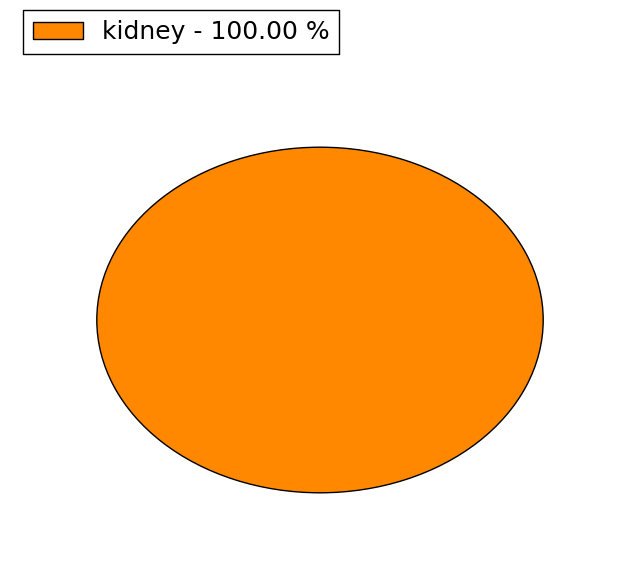 |
(# total SNVs=0) | (# total SNVs=0) |
| Top |
| * When you move the cursor on each content, you can see more deailed mutation information on the Tooltip. Those are primary_site,primary_histology,mutation(aa),pubmedID. |
| GRCh37 position | Mutation(aa) | Unique sampleID count |
| chr1:110211966-110211966 | p.R78W | 2 |
| chr1:110212119-110212119 | p.R96C | 2 |
| chr1:110217413-110217413 | p.L204L | 2 |
| chr1:110211103-110211103 | p.K31N | 1 |
| chr1:110212182-110212182 | p.D117N | 1 |
| chr1:110211575-110211575 | p.L47L | 1 |
| chr1:110212186-110212186 | p.P118L | 1 |
| chr1:110211600-110211600 | p.D56Y | 1 |
| chr1:110213924-110213924 | p.E126K | 1 |
| chr1:110211610-110211610 | p.N59S | 1 |
| Top |
|
 |
| Point Mutation/ Tissue ID | 1 | 2 | 3 | 4 | 5 | 6 | 7 | 8 | 9 | 10 | 11 | 12 | 13 | 14 | 15 | 16 | 17 | 18 | 19 | 20 |
| # sample | 2 | 3 | 1 | 1 | 2 | 1 | 2 | 2 | 2 | |||||||||||
| # mutation | 2 | 3 | 1 | 1 | 2 | 2 | 3 | 2 | 2 | |||||||||||
| nonsynonymous SNV | 1 | 3 | 1 | 2 | 1 | 2 | 1 | 2 | ||||||||||||
| synonymous SNV | 1 | 1 | 1 | 1 | 1 |
| cf) Tissue ID; Tissue type (1; BLCA[Bladder Urothelial Carcinoma], 2; BRCA[Breast invasive carcinoma], 3; CESC[Cervical squamous cell carcinoma and endocervical adenocarcinoma], 4; COAD[Colon adenocarcinoma], 5; GBM[Glioblastoma multiforme], 6; Glioma Low Grade, 7; HNSC[Head and Neck squamous cell carcinoma], 8; KICH[Kidney Chromophobe], 9; KIRC[Kidney renal clear cell carcinoma], 10; KIRP[Kidney renal papillary cell carcinoma], 11; LAML[Acute Myeloid Leukemia], 12; LUAD[Lung adenocarcinoma], 13; LUSC[Lung squamous cell carcinoma], 14; OV[Ovarian serous cystadenocarcinoma ], 15; PAAD[Pancreatic adenocarcinoma], 16; PRAD[Prostate adenocarcinoma], 17; SKCM[Skin Cutaneous Melanoma], 18:STAD[Stomach adenocarcinoma], 19:THCA[Thyroid carcinoma], 20:UCEC[Uterine Corpus Endometrial Carcinoma]) |
| Top |
| * We represented just top 10 SNVs. When you move the cursor on each content, you can see more deailed mutation information on the Tooltip. Those are primary_site, primary_histology, mutation(aa), pubmedID. |
| Genomic Position | Mutation(aa) | Unique sampleID count |
| chr1:110217413 | p.L204L | 2 |
| chr1:110211933 | p.R82H,GSTM2 | 1 |
| chr1:110211979 | p.R96C,GSTM2 | 1 |
| chr1:110217428 | p.D106N,GSTM2 | 1 |
| chr1:110212119 | p.P118L,GSTM2 | 1 |
| chr1:110212149 | p.E126K,GSTM2 | 1 |
| chr1:110212186 | p.A130G,GSTM2 | 1 |
| chr1:110213924 | p.L149I,GSTM2 | 1 |
| chr1:110213937 | p.V163I,GSTM2 | 1 |
| chr1:110211085 | p.V163A,GSTM2 | 1 |
| * Copy number data were extracted from TCGA using R package TCGA-Assembler. The URLs of all public data files on TCGA DCC data server were gathered on Jan-05-2015. Function ProcessCNAData in TCGA-Assembler package was used to obtain gene-level copy number value which is calculated as the average copy number of the genomic region of a gene. |
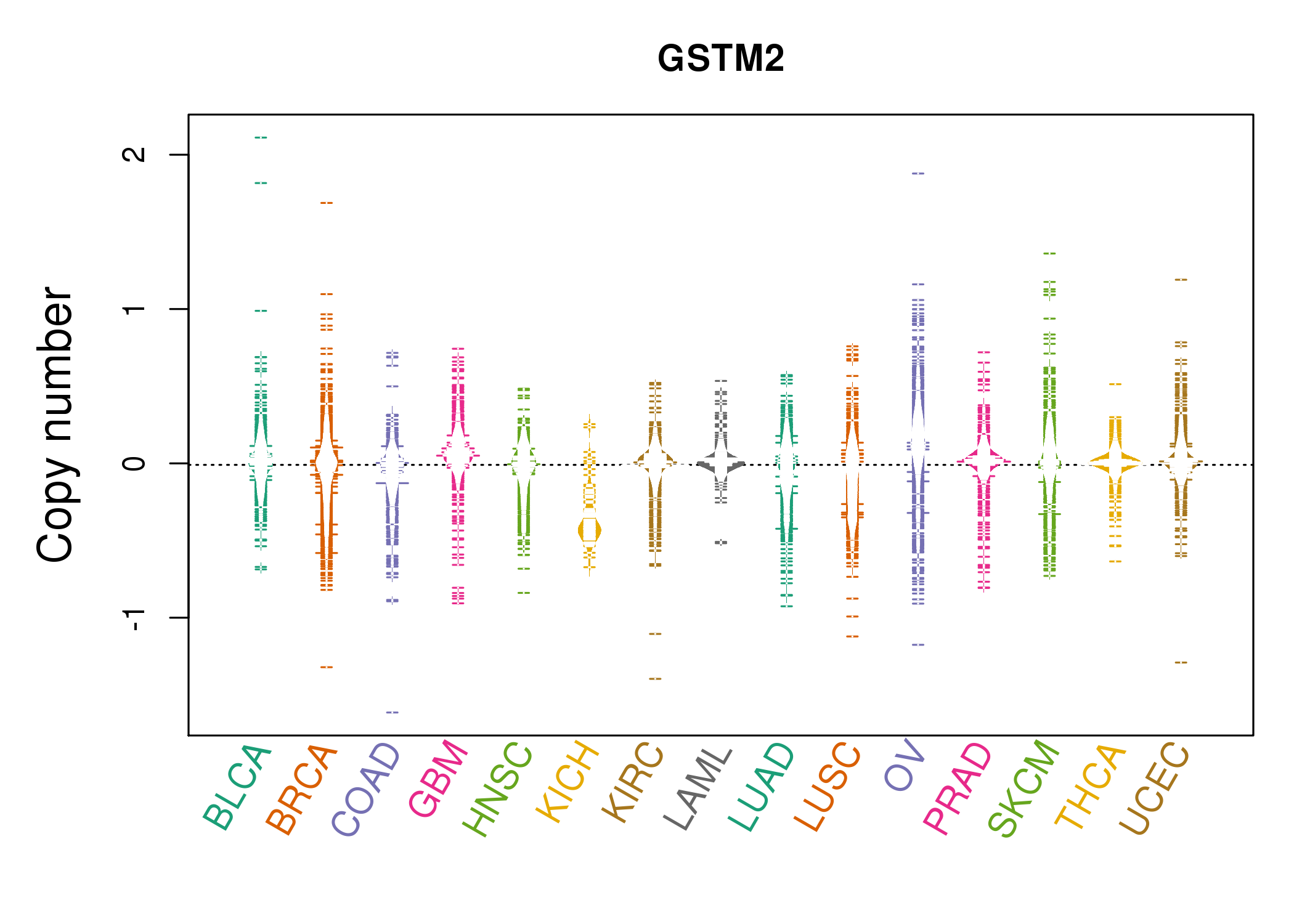 |
| cf) Tissue ID[Tissue type]: BLCA[Bladder Urothelial Carcinoma], BRCA[Breast invasive carcinoma], CESC[Cervical squamous cell carcinoma and endocervical adenocarcinoma], COAD[Colon adenocarcinoma], GBM[Glioblastoma multiforme], Glioma Low Grade, HNSC[Head and Neck squamous cell carcinoma], KICH[Kidney Chromophobe], KIRC[Kidney renal clear cell carcinoma], KIRP[Kidney renal papillary cell carcinoma], LAML[Acute Myeloid Leukemia], LUAD[Lung adenocarcinoma], LUSC[Lung squamous cell carcinoma], OV[Ovarian serous cystadenocarcinoma ], PAAD[Pancreatic adenocarcinoma], PRAD[Prostate adenocarcinoma], SKCM[Skin Cutaneous Melanoma], STAD[Stomach adenocarcinoma], THCA[Thyroid carcinoma], UCEC[Uterine Corpus Endometrial Carcinoma] |
| Top |
| Gene Expression for GSTM2 |
| * CCLE gene expression data were extracted from CCLE_Expression_Entrez_2012-10-18.res: Gene-centric RMA-normalized mRNA expression data. |
 |
| * Normalized gene expression data of RNASeqV2 was extracted from TCGA using R package TCGA-Assembler. The URLs of all public data files on TCGA DCC data server were gathered at Jan-05-2015. Only eight cancer types have enough normal control samples for differential expression analysis. (t test, adjusted p<0.05 (using Benjamini-Hochberg FDR)) |
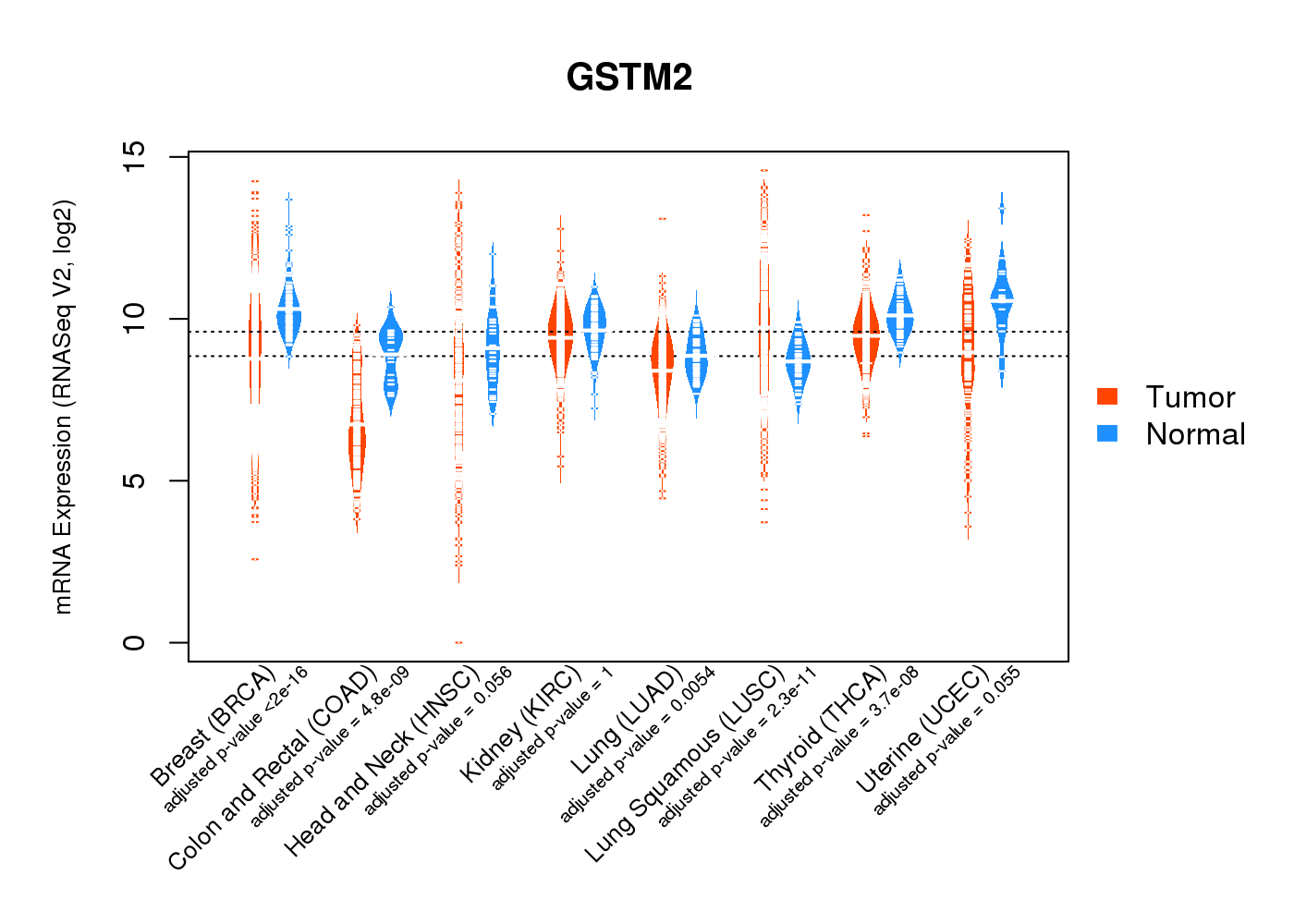 |
| Top |
| * This plots show the correlation between CNV and gene expression. |
: Open all plots for all cancer types
 |
|
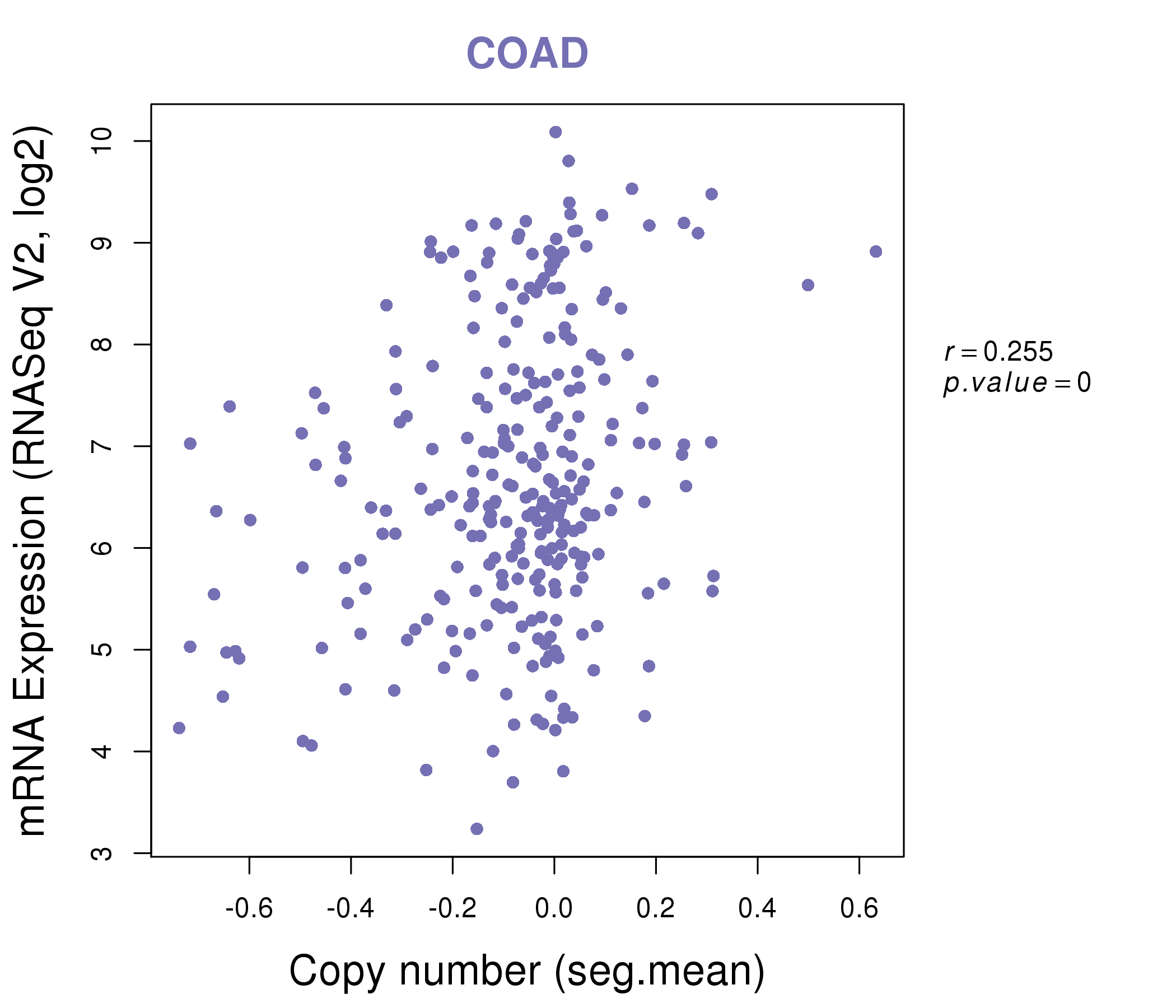 |
|
| Top |
| Gene-Gene Network Information |
| * Co-Expression network figures were drawn using R package igraph. Only the top 20 genes with the highest correlations were shown. Red circle: input gene, orange circle: cell metabolism gene, sky circle: other gene |
: Open all plots for all cancer types
 |
| ||||
| ACAA1,APOD,CLPSL2,CCBL1,CCDC152,CCDC57,CHRNA10, DCXR,DHRS4,DHRS4L2,ECHDC2,GAMT,GSTM1,GSTM2, GSTM2P1,GSTM3,GSTM4,MYPN,REEP6,TP53TG1,TTC36 | ADAM2,APOD,DHRS2,ENPP3,FDFT1,GSTM1,GSTM2, HAAO,HIST1H4H,NANOG,NAT2,PLA2G4E,PNLIPRP3,PPEF1, SERHL2,SERHL,SLC15A1,SNAP91,SPINK8,SULT1C3,UGT2B11 | ||||
 |
| ||||
| ADHFE1,ANKRD53,BHMT2,MILR1,CC2D2B,CORO6,CXCL12, EVL,GRM5,GSTM1,GSTM2,GSTM5,HVCN1,IL18BP, KLHDC7B,KRT1,LOC144571,NRROS,MBL1P,PCDH9,VEGFC | AGPAT4,AGTR2,PIANP,SERTM1,C1orf194,CLVS1,FOXF1, GSTM1,GSTM2,KCNQ2,LOC339047,MAGED4B,MAPT,PLA2G2C, RYR2,SHC2,SOX11,TMEM178A,TRIP6,UNC80,ZNF578 |
| * Co-Expression network figures were drawn using R package igraph. Only the top 20 genes with the highest correlations were shown. Red circle: input gene, orange circle: cell metabolism gene, sky circle: other gene |
: Open all plots for all cancer types
| Top |
: Open all interacting genes' information including KEGG pathway for all interacting genes from DAVID
| Top |
| Pharmacological Information for GSTM2 |
| DB Category | DB Name | DB's ID and Url link |
| * Gene Centered Interaction Network. |
 |
| * Drug Centered Interaction Network. |
| DrugBank ID | Target Name | Drug Groups | Generic Name | Drug Centered Network | Drug Structure |
| DB00143 | glutathione S-transferase mu 2 (muscle) | approved; nutraceutical | Glutathione |  |  |
| DB02458 | glutathione S-transferase mu 2 (muscle) | experimental | Glutathione S-(2,4 Dinitrobenzene) | 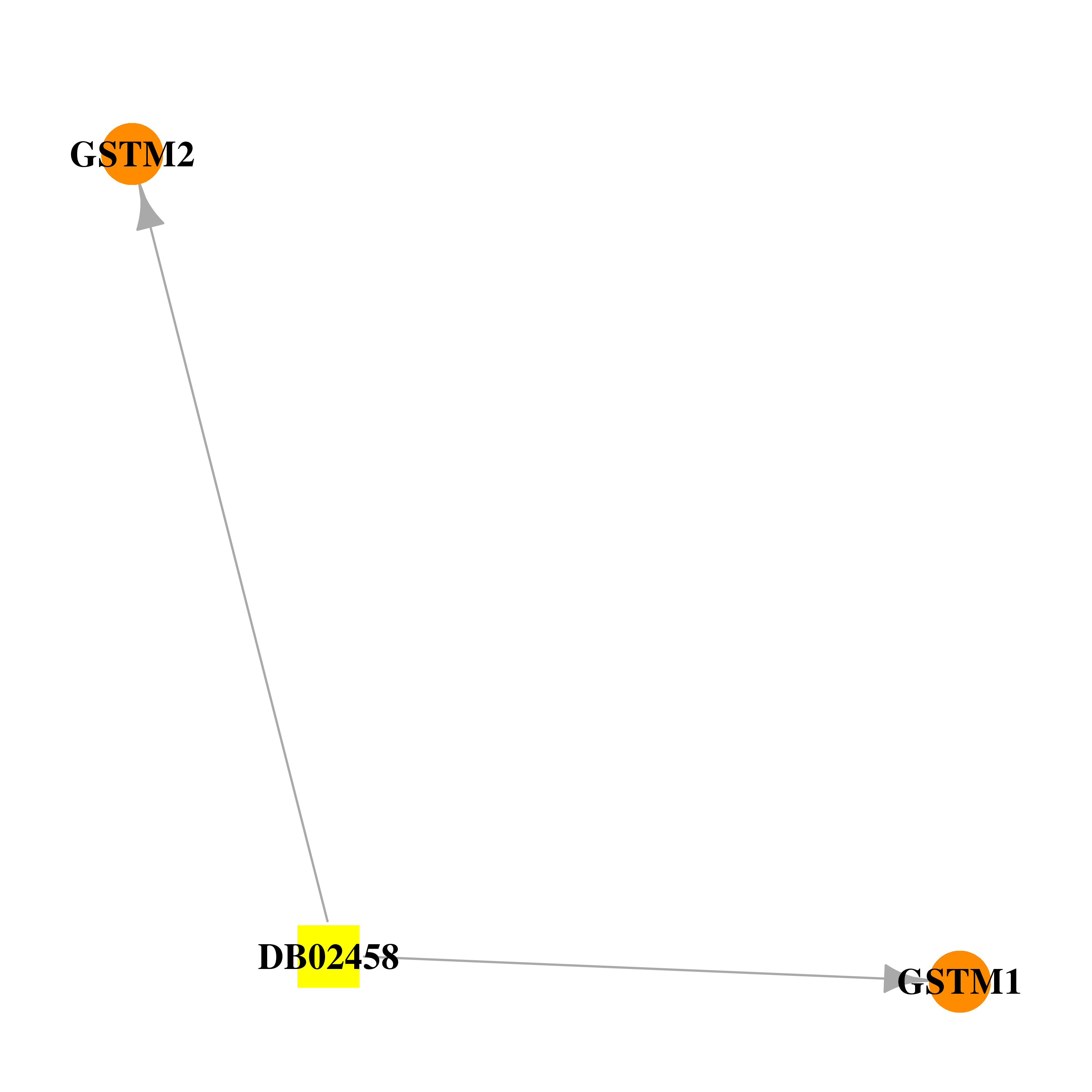 |  |
| DB03310 | glutathione S-transferase mu 2 (muscle) | experimental | Oxidized Glutathione Disulfide |  |  |
| DB04701 | glutathione S-transferase mu 2 (muscle) | experimental | S-METHYL-GLUTATHIONE | 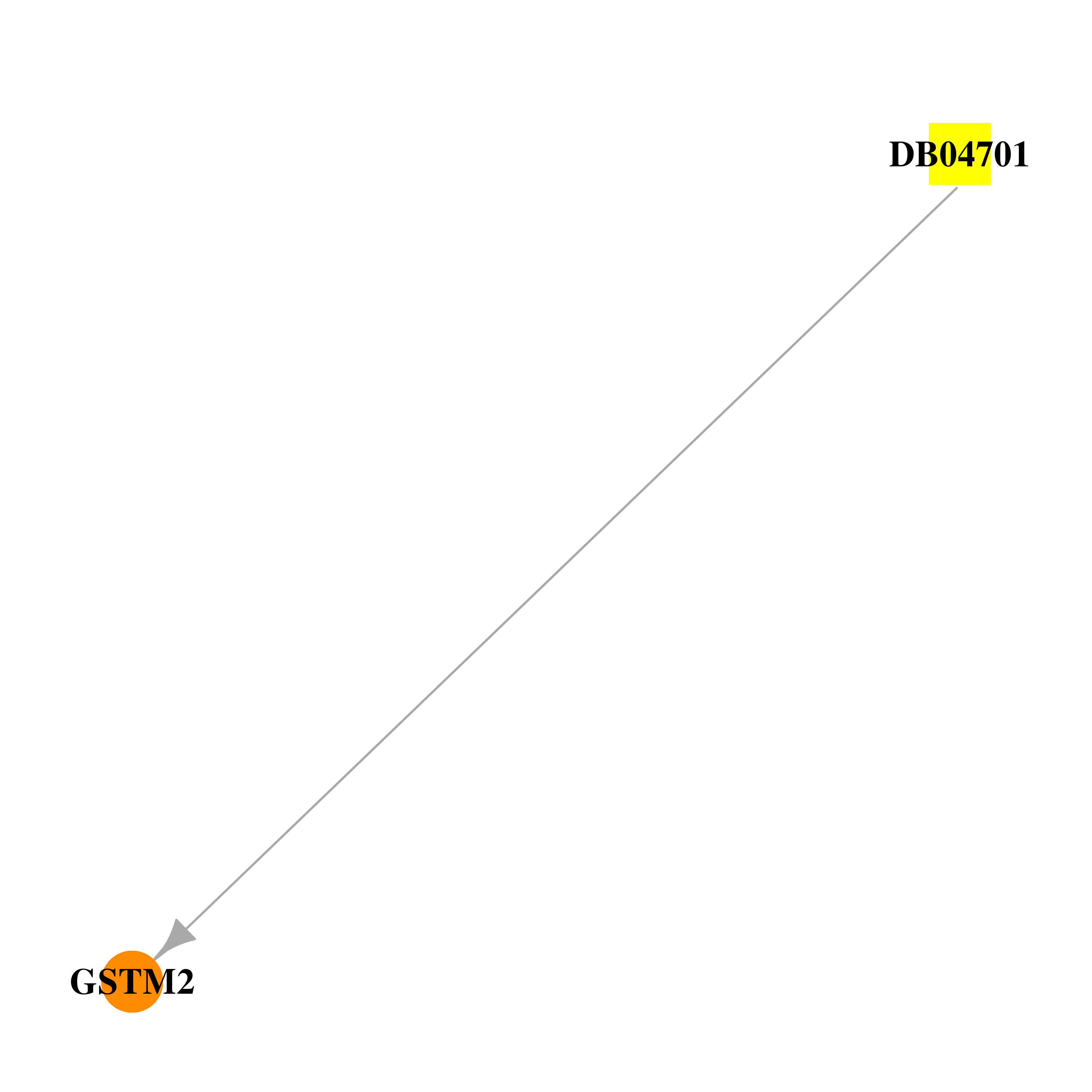 | 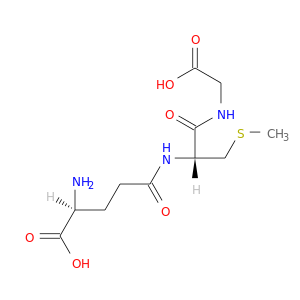 |
| DB00515 | glutathione S-transferase mu 2 (muscle) | approved | Cisplatin |  |  |
| DB01008 | glutathione S-transferase mu 2 (muscle) | approved; investigational | Busulfan |  |  |
| DB00988 | glutathione S-transferase mu 2 (muscle) | approved | Dopamine | 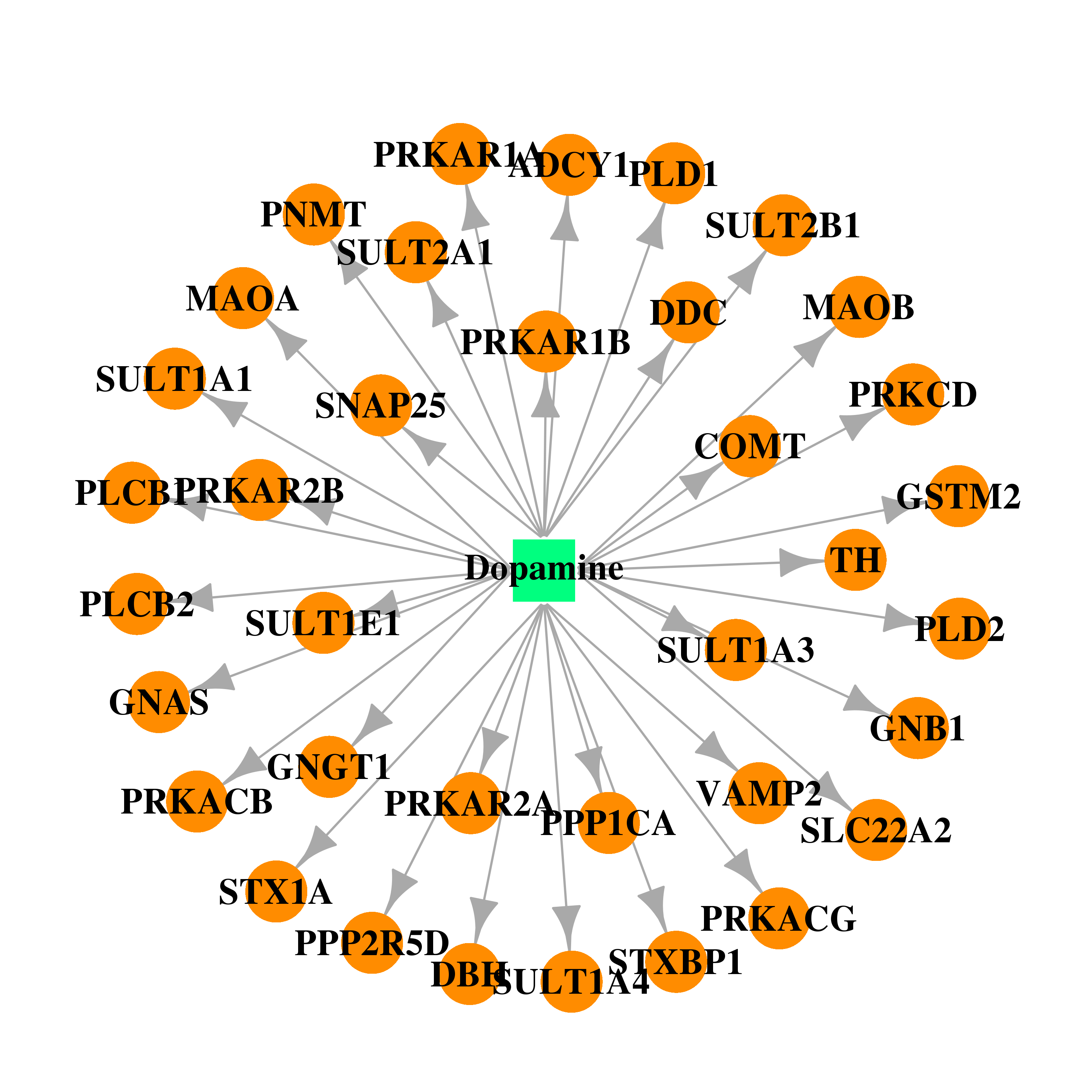 | 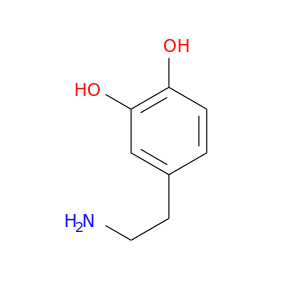 |
| DB00668 | glutathione S-transferase mu 2 (muscle) | approved | Epinephrine |  |  |
| Top |
| Cross referenced IDs for GSTM2 |
| * We obtained these cross-references from Uniprot database. It covers 150 different DBs, 18 categories. http://www.uniprot.org/help/cross_references_section |
: Open all cross reference information
|
Copyright © 2016-Present - The Univsersity of Texas Health Science Center at Houston @ |






